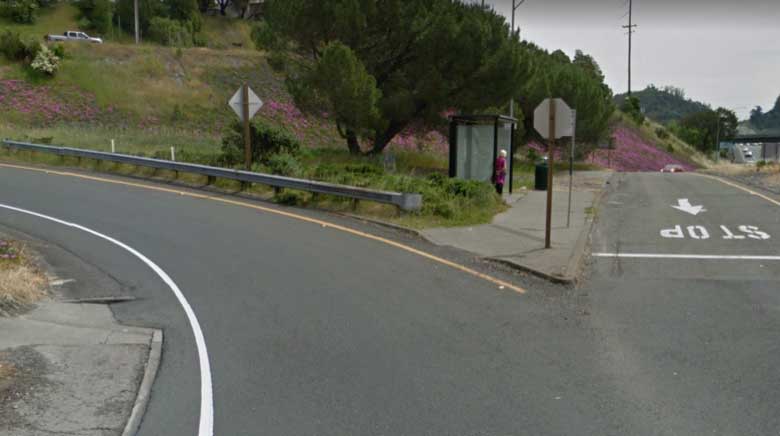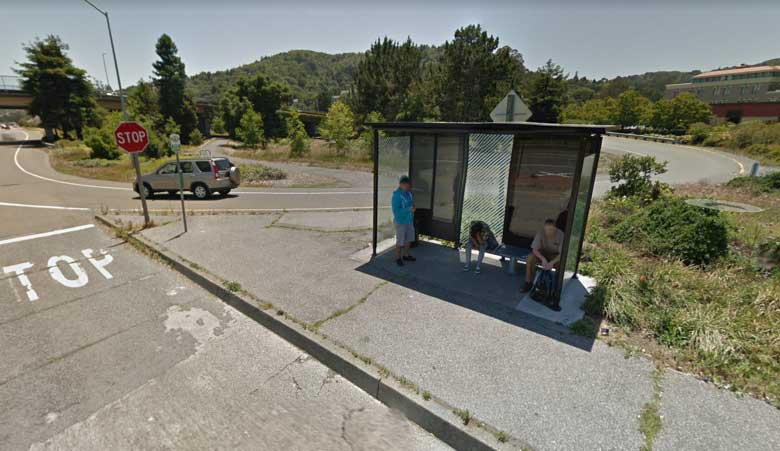
The Paradise Drive bus pad in Corte Madera can only be accessed by walking across a high-speed cloverleaf onramp. (Source: Google Streetview)
Highway 101 is the transportation backbone of Marin County, both for people driving and riding the bus. Over two dozen bus routes by Golden Gate Transit and Marin Transit operate along 101, providing regional express connections to San Francisco and Sonoma Counties as well as serving trips within Marin County. A unique feature of these bus routes is their stops along 101: 14 stops span Sausalito to Novato on the freeway shoulders. These “bus pads” play a critical role in connecting Marin’s communities via transit, serving key destinations, local bus transfers, and park-and-rides. However, their hazardous conditions put bus riders in danger.
Marin’s bus pads are mostly located in the middle of high-speed cloverleaf interchanges without necessary pedestrian safety features. The stops themselves have nothing more than a bus sign and shelter – lacking lighting, wayfinding, real-time arrival information, off-board fare collection, or other core features expected along a high-frequency trunk corridor. What is most troubling about these stops is that many are only accessible by long, poorly marked walkways that force bus riders to walk across high-speed onramps. A relic of the 1960s, these pedestrian crossings lack CA-MUTCD-compliant signage, PROWAG-compliant curb ramps, and pedestrian-scaled lighting. Every time a bus rider uses one of these stops, they’re taking their lives into their own hands when crossing freeway onramps on foot – especially at night, during bad weather, or if a rider is in a wheelchair or visually impaired.
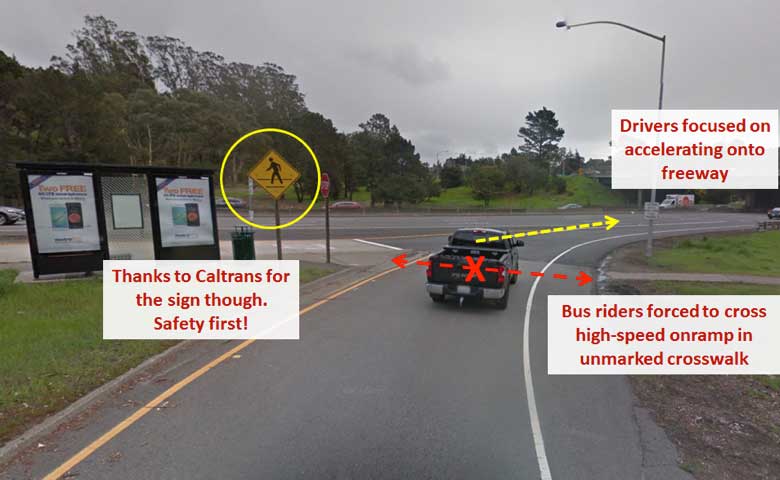
Unsafe conditions at the Tiburon Wye bus pad are typical of most freeway bus stops in Marin County. (Source: Google Streetview)
From a driver’s perspective, the presence of pedestrians crossing freeway onramps is completely counterintuitive. Entering an onramp signifies the transition from a local street to freeway: as a driver accelerates around the bend and prepares to merge, the last thing he or she expects is a pedestrian crossing the ramp. The omission of crosswalk signage, markings, and lighting exacerbates the unexpectedness of encountering pedestrians. Catching a driver off-guard in these locations can be deadly.
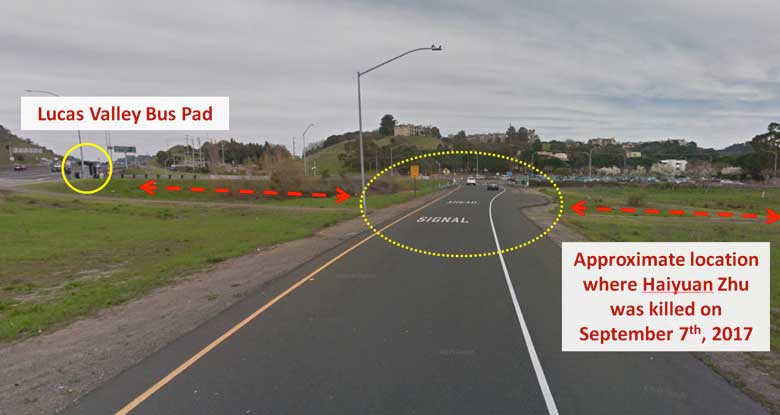
Last month, Haiyuan Zhu, 66, was killed in a hit and run while crossing the northbound 101 offramp at Lucas Valley Road in an unmarked and unsigned crosswalk. (Source: Google Streetview)
The hazardous conditions of Marin’s bus pads have resulted in a series of tragedies disproportionately affecting the county’s lower income communities and communities of color. Between 2006 and 2015, approximately 35 reported pedestrian injury collisions and two deaths occurred at interchanges with bus pads. Just last month, Haiyuan Zhu was killed in a hit and run while walking from the Lucas Valley bus pad across the northbound offramp at an unmarked, unsigned crosswalk at night. Two-thirds of victims of reported pedestrian injury collisions near bus pads have been people of color. Whereas wealthier white Marin residents often opt to drive or ride SMART or the ferry, Marin’s bus riders are disproportionately lower income (77 percent of riders from households with incomes less than $50,000, versus 30 percent of the county as a whole) and people of color (61 percent of riders are not white, versus 27 percent of the county as a whole). The County’s disinvestment in basic safety improvements adversely affects its most disadvantaged residents the most.
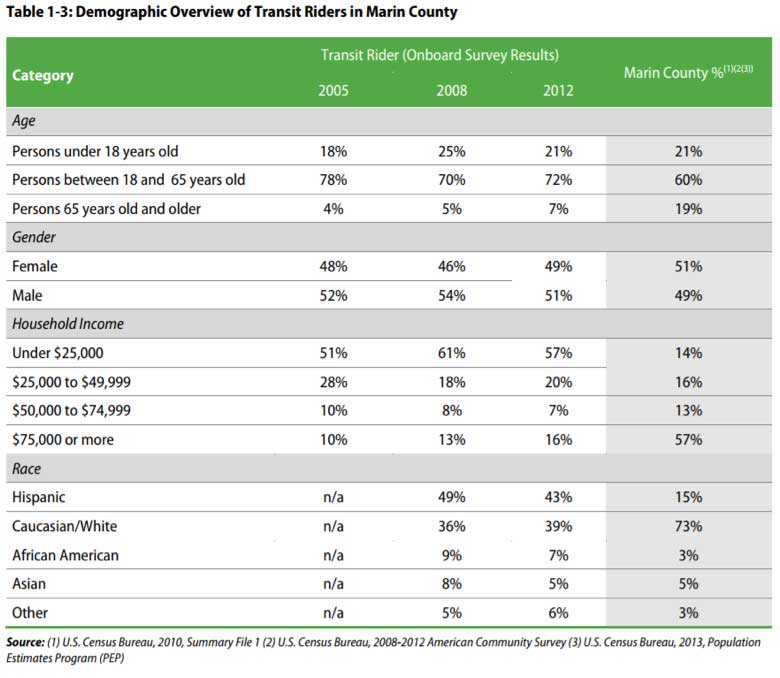
Transit riders in Marin County are disproportionately lower income people of color relative to the county population as a whole. (Source: Marin Transit)
There are relatively low cost solutions for ensuring bus riders can safety and comfortably access stops. In the near term, the County and Caltrans should provide crosswalk striping, signage, and lighting to improve visibility of pedestrians. Metering lights with pedestrian actuation should also be added to create signalized crossings. The most problematic locations – such as the Lucas Valley Road offramp where Haiyuan Zhu was killed – should be closed. Over the long term, interchanges should be redesigned to remove pedestrian crossings of onramps and provide more direct access to neighborhoods, bus transfers, and park-and-rides, either by removing cloverleaf interchanges and relocating bus stops to the street level (as is being done at the Tiburon Boulevard/E Blithedale interchange) or by adding stairs and elevators to provide direct connections to overpasses. In both cases, more inviting shelters with enhanced amenities should be added.
Relative to the hundreds of millions of dollars that the County is spending on SMART and widening the Novato Narrows, the cost of providing basic improvements to 101’s bus pads would be small. Yet, these improvements could go a long way toward making riding the bus a safer and more inviting experience. Marin County needs action to address these critical safety needs before another tragedy occurs.

